Taxation Law: Capital Gains, Fringe Benefits, and Property Issues
VerifiedAdded on 2020/02/24
|8
|1481
|56
Report
AI Summary
This report provides an analysis of several taxation law issues. Question 1 addresses capital gains tax, calculating gains and losses from the sale of various assets, and applying the discounted method for long-term assets. Question 2 examines fringe benefits tax, specifically a car loan provided by an employer at a special interest rate, and calculates the taxable value of the benefit. Question 3 explores the division of rental property income and losses between co-owners, referencing relevant tax rulings and case law. Question 4 discusses the concept of tax avoidance and the right to manage one's affairs to minimize tax liability, referencing the Duke of Westminster case. Finally, Question 5 deals with the taxation of income from timber products and standing timber, determining whether it is taxed as ordinary income or capital gains. The report uses relevant legal provisions, case analysis, and conclusions to address each issue.
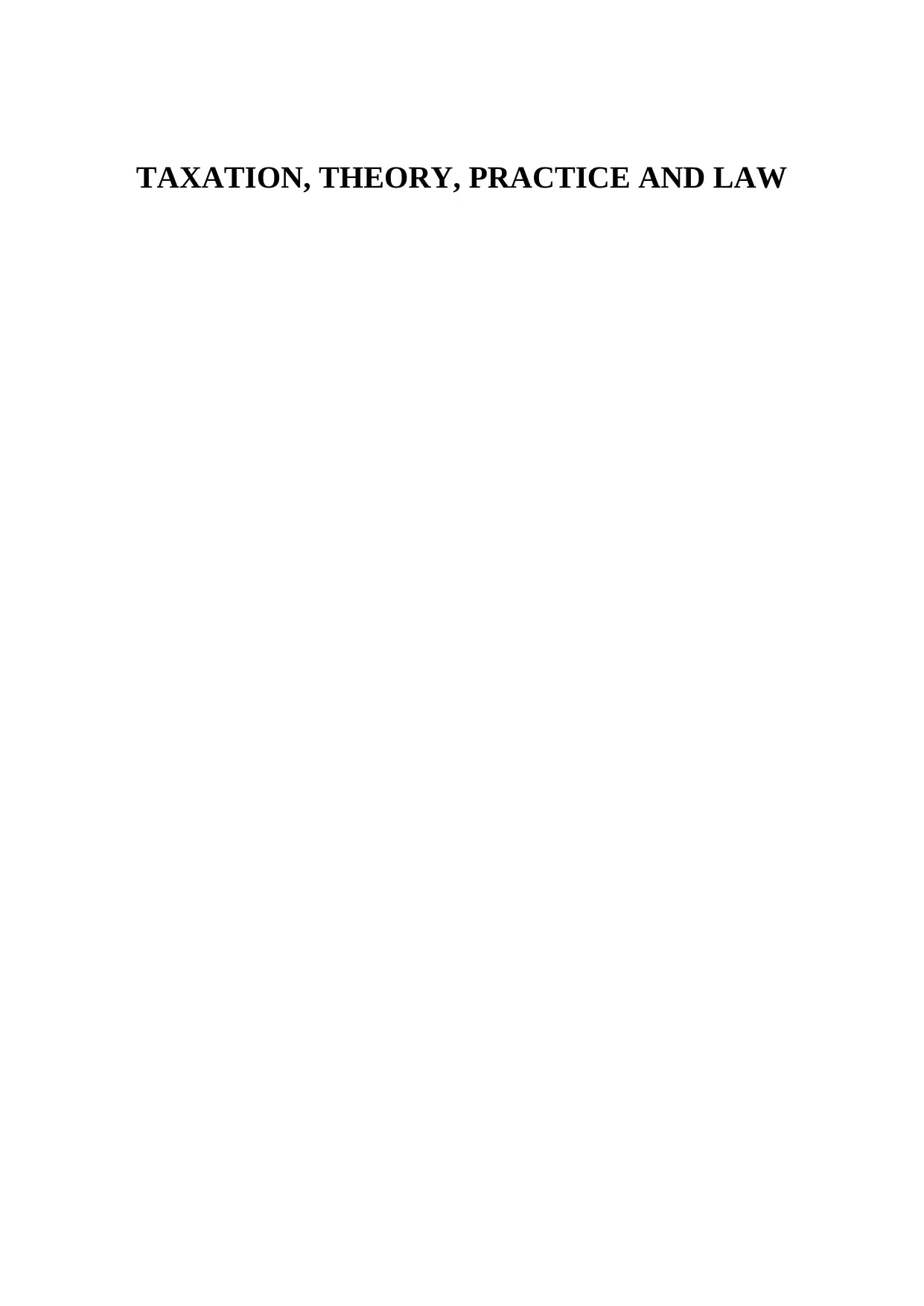
TAXATION, THEORY, PRACTICE AND LAW
Paraphrase This Document
Need a fresh take? Get an instant paraphrase of this document with our AI Paraphraser
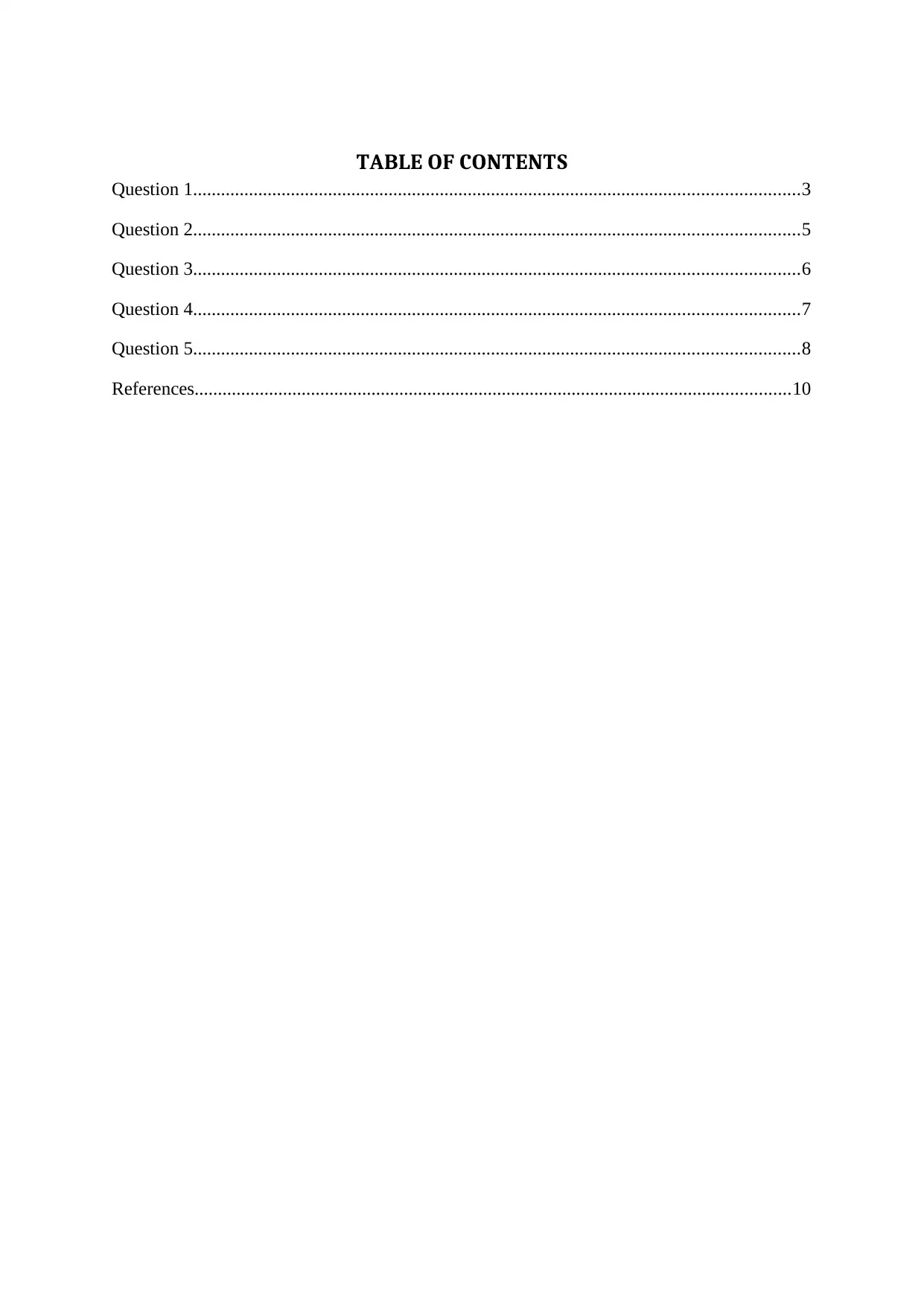
TABLE OF CONTENTS
Question 1..................................................................................................................................3
Question 2..................................................................................................................................5
Question 3..................................................................................................................................6
Question 4..................................................................................................................................7
Question 5..................................................................................................................................8
References................................................................................................................................10
Question 1..................................................................................................................................3
Question 2..................................................................................................................................5
Question 3..................................................................................................................................6
Question 4..................................................................................................................................7
Question 5..................................................................................................................................8
References................................................................................................................................10
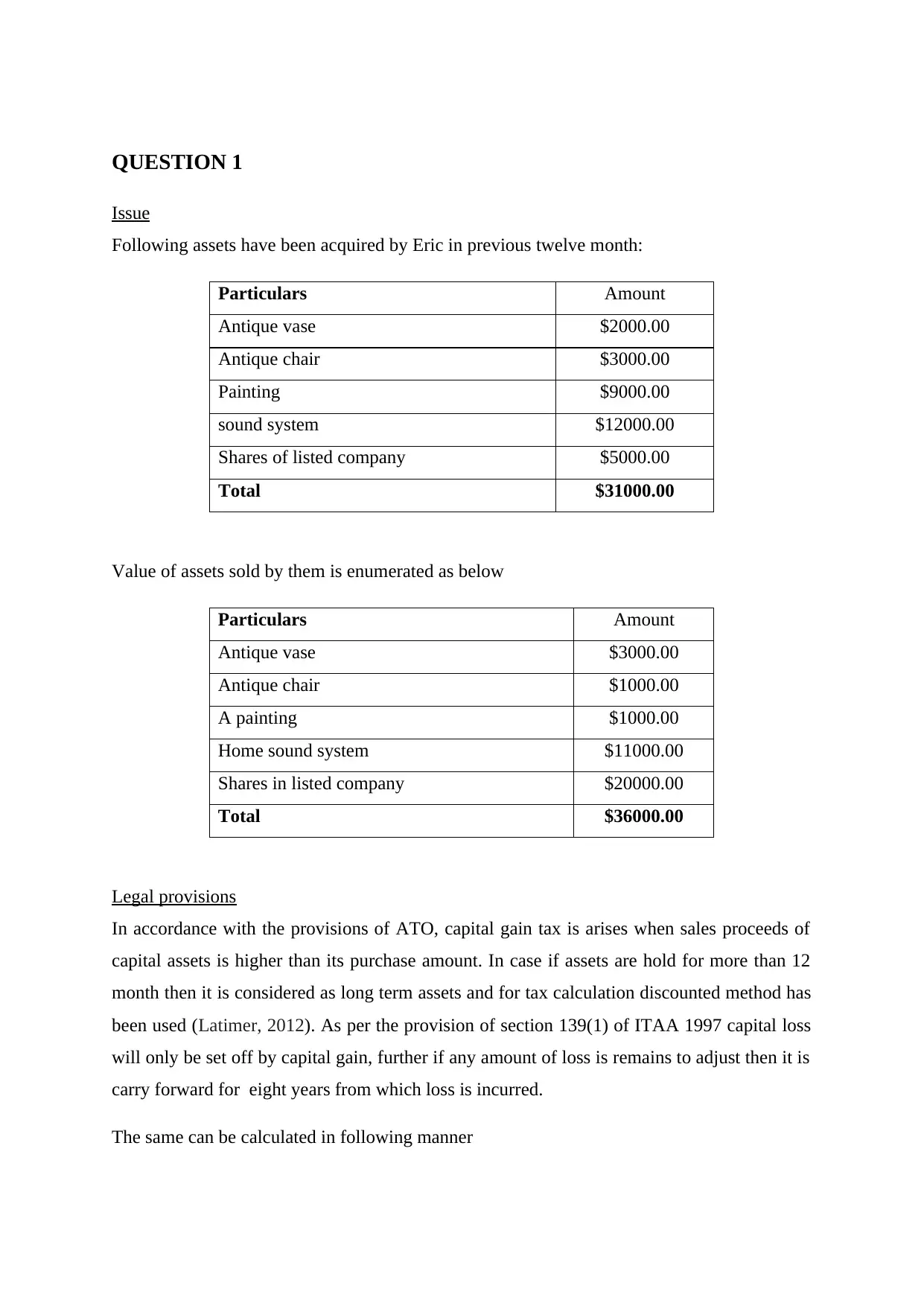
QUESTION 1
Issue
Following assets have been acquired by Eric in previous twelve month:
Particulars Amount
Antique vase $2000.00
Antique chair $3000.00
Painting $9000.00
sound system $12000.00
Shares of listed company $5000.00
Total $31000.00
Value of assets sold by them is enumerated as below
Particulars Amount
Antique vase $3000.00
Antique chair $1000.00
A painting $1000.00
Home sound system $11000.00
Shares in listed company $20000.00
Total $36000.00
Legal provisions
In accordance with the provisions of ATO, capital gain tax is arises when sales proceeds of
capital assets is higher than its purchase amount. In case if assets are hold for more than 12
month then it is considered as long term assets and for tax calculation discounted method has
been used (Latimer, 2012). As per the provision of section 139(1) of ITAA 1997 capital loss
will only be set off by capital gain, further if any amount of loss is remains to adjust then it is
carry forward for eight years from which loss is incurred.
The same can be calculated in following manner
Issue
Following assets have been acquired by Eric in previous twelve month:
Particulars Amount
Antique vase $2000.00
Antique chair $3000.00
Painting $9000.00
sound system $12000.00
Shares of listed company $5000.00
Total $31000.00
Value of assets sold by them is enumerated as below
Particulars Amount
Antique vase $3000.00
Antique chair $1000.00
A painting $1000.00
Home sound system $11000.00
Shares in listed company $20000.00
Total $36000.00
Legal provisions
In accordance with the provisions of ATO, capital gain tax is arises when sales proceeds of
capital assets is higher than its purchase amount. In case if assets are hold for more than 12
month then it is considered as long term assets and for tax calculation discounted method has
been used (Latimer, 2012). As per the provision of section 139(1) of ITAA 1997 capital loss
will only be set off by capital gain, further if any amount of loss is remains to adjust then it is
carry forward for eight years from which loss is incurred.
The same can be calculated in following manner
⊘ This is a preview!⊘
Do you want full access?
Subscribe today to unlock all pages.

Trusted by 1+ million students worldwide
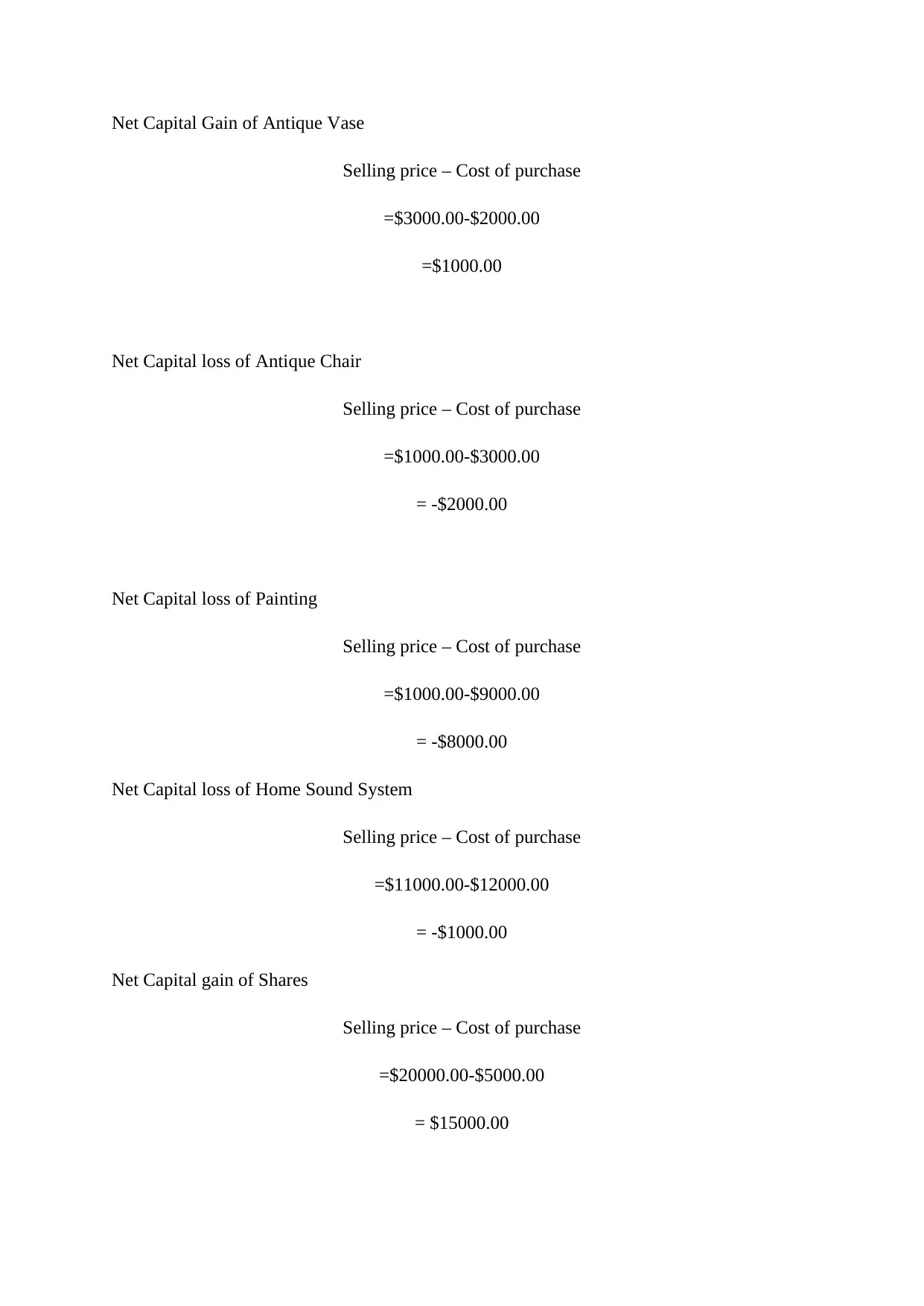
Net Capital Gain of Antique Vase
Selling price – Cost of purchase
=$3000.00-$2000.00
=$1000.00
Net Capital loss of Antique Chair
Selling price – Cost of purchase
=$1000.00-$3000.00
= -$2000.00
Net Capital loss of Painting
Selling price – Cost of purchase
=$1000.00-$9000.00
= -$8000.00
Net Capital loss of Home Sound System
Selling price – Cost of purchase
=$11000.00-$12000.00
= -$1000.00
Net Capital gain of Shares
Selling price – Cost of purchase
=$20000.00-$5000.00
= $15000.00
Selling price – Cost of purchase
=$3000.00-$2000.00
=$1000.00
Net Capital loss of Antique Chair
Selling price – Cost of purchase
=$1000.00-$3000.00
= -$2000.00
Net Capital loss of Painting
Selling price – Cost of purchase
=$1000.00-$9000.00
= -$8000.00
Net Capital loss of Home Sound System
Selling price – Cost of purchase
=$11000.00-$12000.00
= -$1000.00
Net Capital gain of Shares
Selling price – Cost of purchase
=$20000.00-$5000.00
= $15000.00
Paraphrase This Document
Need a fresh take? Get an instant paraphrase of this document with our AI Paraphraser
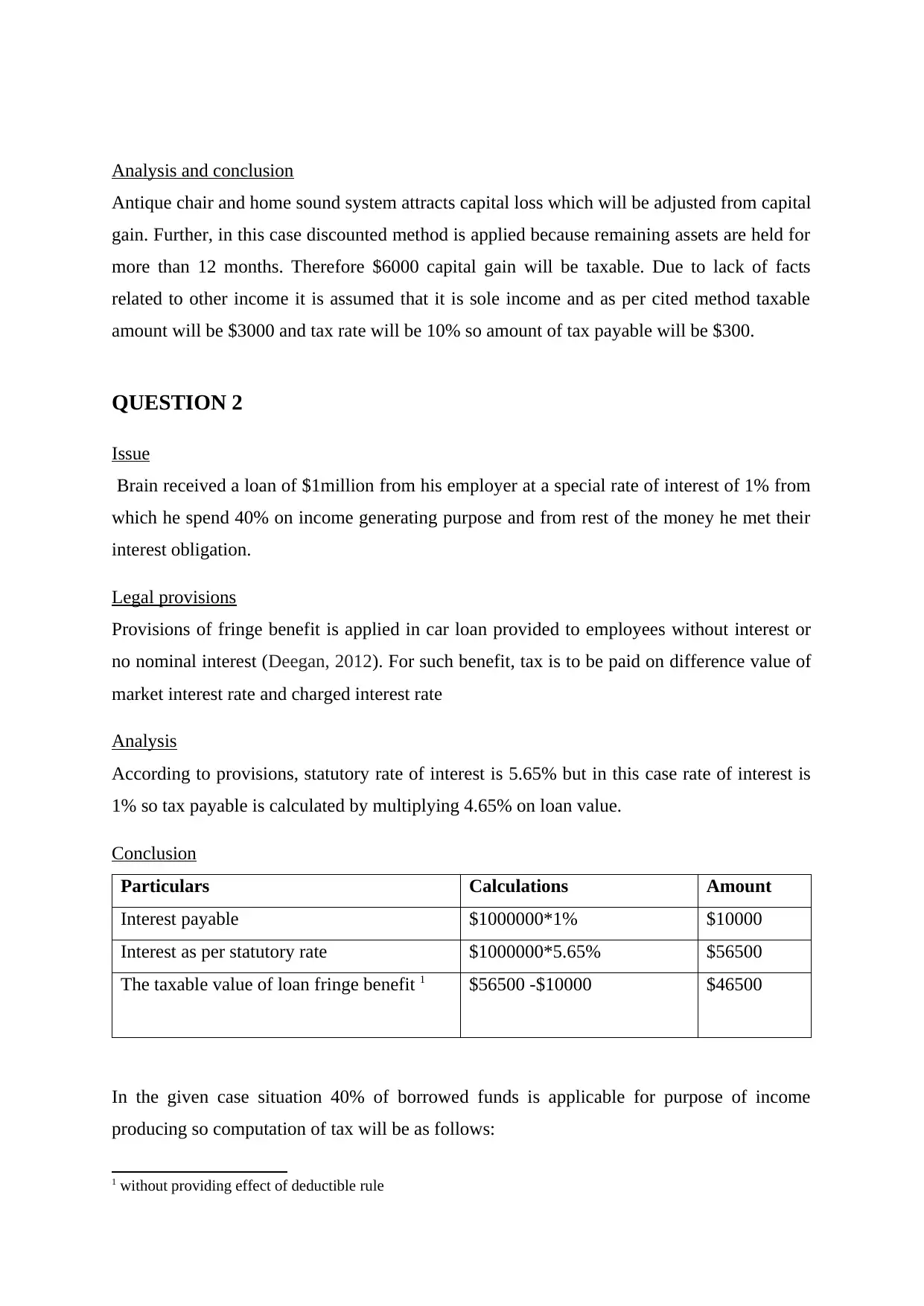
Analysis and conclusion
Antique chair and home sound system attracts capital loss which will be adjusted from capital
gain. Further, in this case discounted method is applied because remaining assets are held for
more than 12 months. Therefore $6000 capital gain will be taxable. Due to lack of facts
related to other income it is assumed that it is sole income and as per cited method taxable
amount will be $3000 and tax rate will be 10% so amount of tax payable will be $300.
QUESTION 2
Issue
Brain received a loan of $1million from his employer at a special rate of interest of 1% from
which he spend 40% on income generating purpose and from rest of the money he met their
interest obligation.
Legal provisions
Provisions of fringe benefit is applied in car loan provided to employees without interest or
no nominal interest (Deegan, 2012). For such benefit, tax is to be paid on difference value of
market interest rate and charged interest rate
Analysis
According to provisions, statutory rate of interest is 5.65% but in this case rate of interest is
1% so tax payable is calculated by multiplying 4.65% on loan value.
Conclusion
Particulars Calculations Amount
Interest payable $1000000*1% $10000
Interest as per statutory rate $1000000*5.65% $56500
The taxable value of loan fringe benefit 1 $56500 -$10000 $46500
In the given case situation 40% of borrowed funds is applicable for purpose of income
producing so computation of tax will be as follows:
1 without providing effect of deductible rule
Antique chair and home sound system attracts capital loss which will be adjusted from capital
gain. Further, in this case discounted method is applied because remaining assets are held for
more than 12 months. Therefore $6000 capital gain will be taxable. Due to lack of facts
related to other income it is assumed that it is sole income and as per cited method taxable
amount will be $3000 and tax rate will be 10% so amount of tax payable will be $300.
QUESTION 2
Issue
Brain received a loan of $1million from his employer at a special rate of interest of 1% from
which he spend 40% on income generating purpose and from rest of the money he met their
interest obligation.
Legal provisions
Provisions of fringe benefit is applied in car loan provided to employees without interest or
no nominal interest (Deegan, 2012). For such benefit, tax is to be paid on difference value of
market interest rate and charged interest rate
Analysis
According to provisions, statutory rate of interest is 5.65% but in this case rate of interest is
1% so tax payable is calculated by multiplying 4.65% on loan value.
Conclusion
Particulars Calculations Amount
Interest payable $1000000*1% $10000
Interest as per statutory rate $1000000*5.65% $56500
The taxable value of loan fringe benefit 1 $56500 -$10000 $46500
In the given case situation 40% of borrowed funds is applicable for purpose of income
producing so computation of tax will be as follows:
1 without providing effect of deductible rule
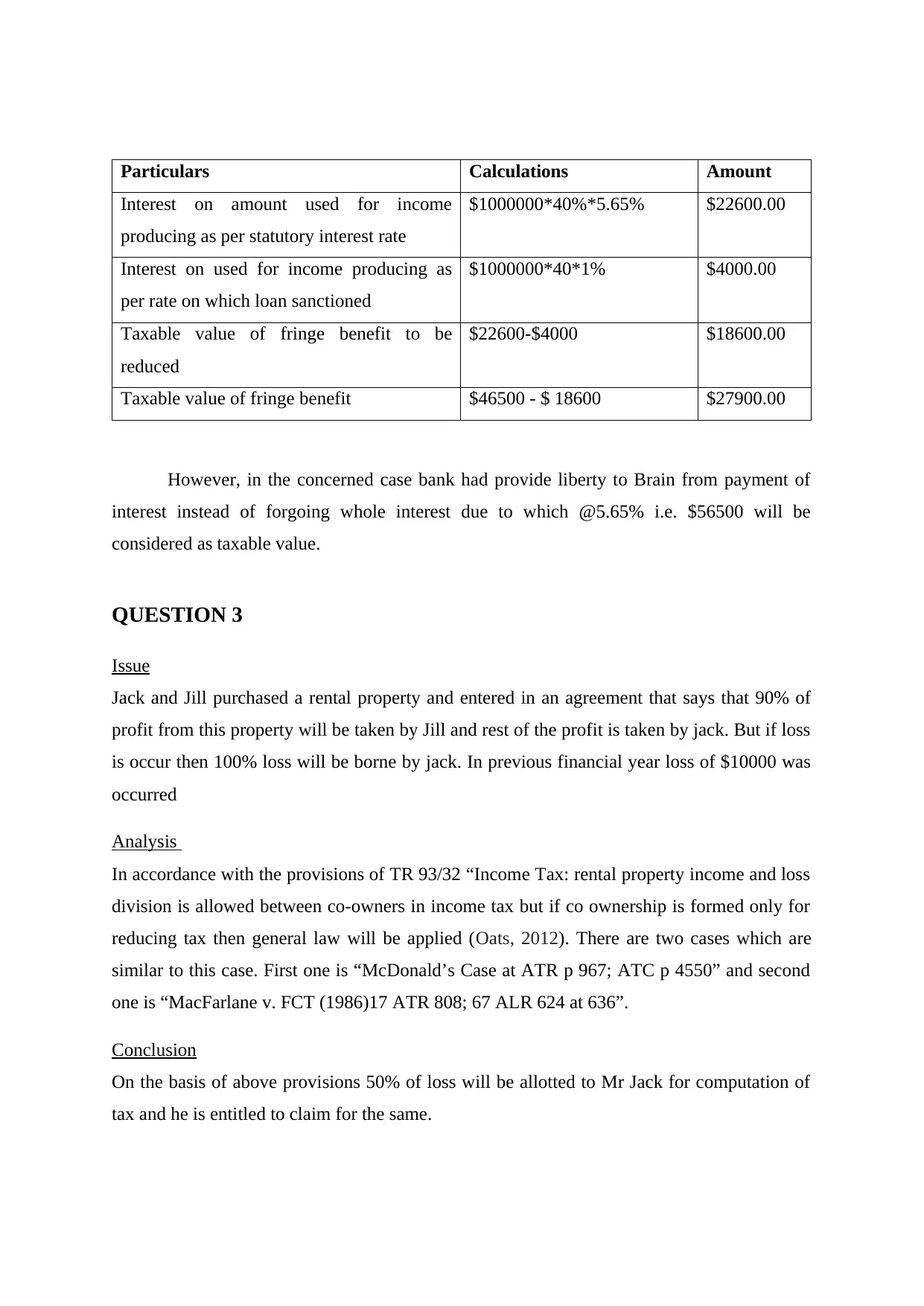
Particulars Calculations Amount
Interest on amount used for income
producing as per statutory interest rate
$1000000*40%*5.65% $22600.00
Interest on used for income producing as
per rate on which loan sanctioned
$1000000*40*1% $4000.00
Taxable value of fringe benefit to be
reduced
$22600-$4000 $18600.00
Taxable value of fringe benefit $46500 - $ 18600 $27900.00
However, in the concerned case bank had provide liberty to Brain from payment of
interest instead of forgoing whole interest due to which @5.65% i.e. $56500 will be
considered as taxable value.
QUESTION 3
Issue
Jack and Jill purchased a rental property and entered in an agreement that says that 90% of
profit from this property will be taken by Jill and rest of the profit is taken by jack. But if loss
is occur then 100% loss will be borne by jack. In previous financial year loss of $10000 was
occurred
Analysis
In accordance with the provisions of TR 93/32 “Income Tax: rental property income and loss
division is allowed between co-owners in income tax but if co ownership is formed only for
reducing tax then general law will be applied (Oats, 2012). There are two cases which are
similar to this case. First one is “McDonald’s Case at ATR p 967; ATC p 4550” and second
one is “MacFarlane v. FCT (1986)17 ATR 808; 67 ALR 624 at 636”.
Conclusion
On the basis of above provisions 50% of loss will be allotted to Mr Jack for computation of
tax and he is entitled to claim for the same.
Interest on amount used for income
producing as per statutory interest rate
$1000000*40%*5.65% $22600.00
Interest on used for income producing as
per rate on which loan sanctioned
$1000000*40*1% $4000.00
Taxable value of fringe benefit to be
reduced
$22600-$4000 $18600.00
Taxable value of fringe benefit $46500 - $ 18600 $27900.00
However, in the concerned case bank had provide liberty to Brain from payment of
interest instead of forgoing whole interest due to which @5.65% i.e. $56500 will be
considered as taxable value.
QUESTION 3
Issue
Jack and Jill purchased a rental property and entered in an agreement that says that 90% of
profit from this property will be taken by Jill and rest of the profit is taken by jack. But if loss
is occur then 100% loss will be borne by jack. In previous financial year loss of $10000 was
occurred
Analysis
In accordance with the provisions of TR 93/32 “Income Tax: rental property income and loss
division is allowed between co-owners in income tax but if co ownership is formed only for
reducing tax then general law will be applied (Oats, 2012). There are two cases which are
similar to this case. First one is “McDonald’s Case at ATR p 967; ATC p 4550” and second
one is “MacFarlane v. FCT (1986)17 ATR 808; 67 ALR 624 at 636”.
Conclusion
On the basis of above provisions 50% of loss will be allotted to Mr Jack for computation of
tax and he is entitled to claim for the same.
⊘ This is a preview!⊘
Do you want full access?
Subscribe today to unlock all pages.

Trusted by 1+ million students worldwide
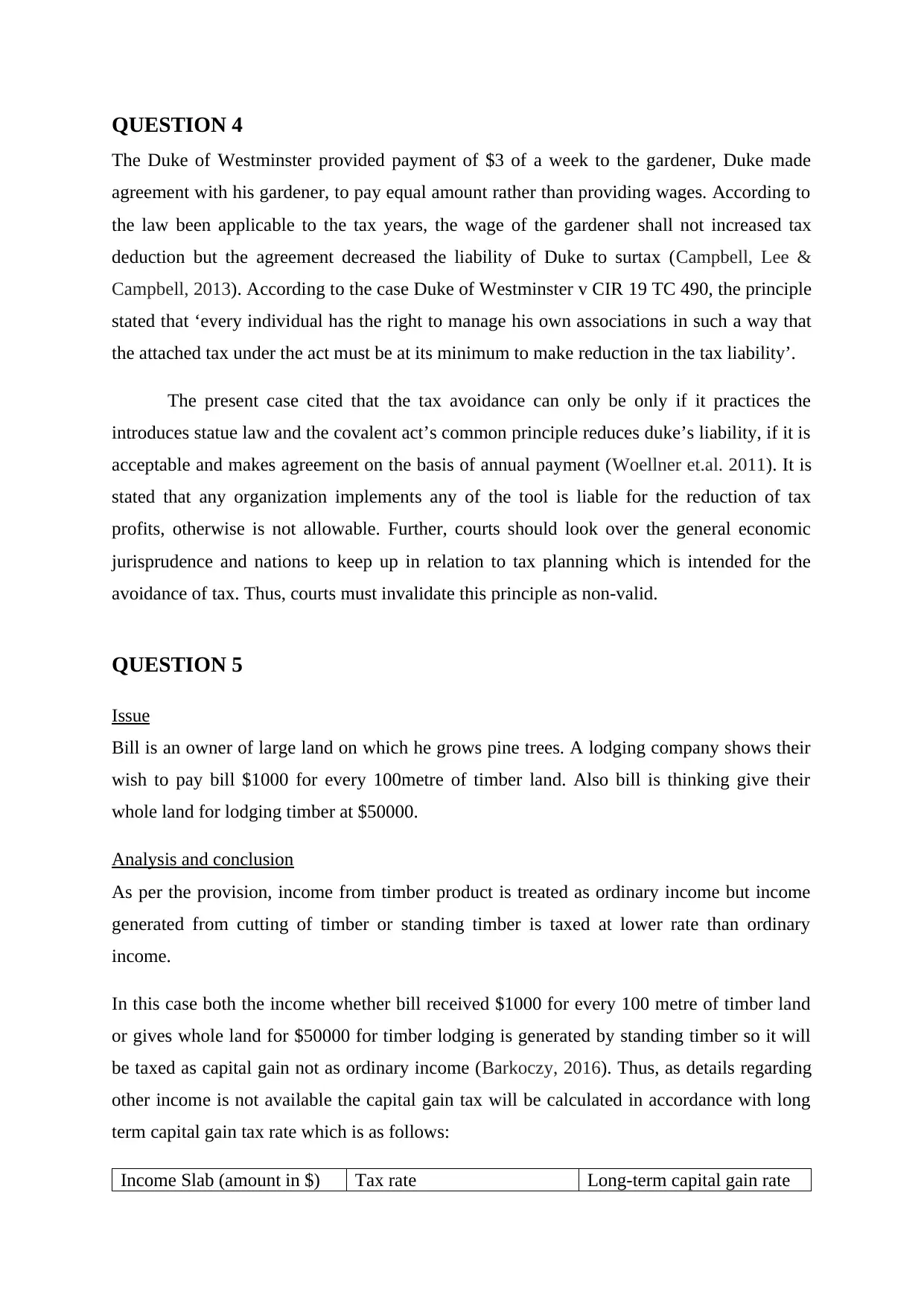
QUESTION 4
The Duke of Westminster provided payment of $3 of a week to the gardener, Duke made
agreement with his gardener, to pay equal amount rather than providing wages. According to
the law been applicable to the tax years, the wage of the gardener shall not increased tax
deduction but the agreement decreased the liability of Duke to surtax (Campbell, Lee &
Campbell, 2013). According to the case Duke of Westminster v CIR 19 TC 490, the principle
stated that ‘every individual has the right to manage his own associations in such a way that
the attached tax under the act must be at its minimum to make reduction in the tax liability’.
The present case cited that the tax avoidance can only be only if it practices the
introduces statue law and the covalent act’s common principle reduces duke’s liability, if it is
acceptable and makes agreement on the basis of annual payment (Woellner et.al. 2011). It is
stated that any organization implements any of the tool is liable for the reduction of tax
profits, otherwise is not allowable. Further, courts should look over the general economic
jurisprudence and nations to keep up in relation to tax planning which is intended for the
avoidance of tax. Thus, courts must invalidate this principle as non-valid.
QUESTION 5
Issue
Bill is an owner of large land on which he grows pine trees. A lodging company shows their
wish to pay bill $1000 for every 100metre of timber land. Also bill is thinking give their
whole land for lodging timber at $50000.
Analysis and conclusion
As per the provision, income from timber product is treated as ordinary income but income
generated from cutting of timber or standing timber is taxed at lower rate than ordinary
income.
In this case both the income whether bill received $1000 for every 100 metre of timber land
or gives whole land for $50000 for timber lodging is generated by standing timber so it will
be taxed as capital gain not as ordinary income (Barkoczy, 2016). Thus, as details regarding
other income is not available the capital gain tax will be calculated in accordance with long
term capital gain tax rate which is as follows:
Income Slab (amount in $) Tax rate Long-term capital gain rate
The Duke of Westminster provided payment of $3 of a week to the gardener, Duke made
agreement with his gardener, to pay equal amount rather than providing wages. According to
the law been applicable to the tax years, the wage of the gardener shall not increased tax
deduction but the agreement decreased the liability of Duke to surtax (Campbell, Lee &
Campbell, 2013). According to the case Duke of Westminster v CIR 19 TC 490, the principle
stated that ‘every individual has the right to manage his own associations in such a way that
the attached tax under the act must be at its minimum to make reduction in the tax liability’.
The present case cited that the tax avoidance can only be only if it practices the
introduces statue law and the covalent act’s common principle reduces duke’s liability, if it is
acceptable and makes agreement on the basis of annual payment (Woellner et.al. 2011). It is
stated that any organization implements any of the tool is liable for the reduction of tax
profits, otherwise is not allowable. Further, courts should look over the general economic
jurisprudence and nations to keep up in relation to tax planning which is intended for the
avoidance of tax. Thus, courts must invalidate this principle as non-valid.
QUESTION 5
Issue
Bill is an owner of large land on which he grows pine trees. A lodging company shows their
wish to pay bill $1000 for every 100metre of timber land. Also bill is thinking give their
whole land for lodging timber at $50000.
Analysis and conclusion
As per the provision, income from timber product is treated as ordinary income but income
generated from cutting of timber or standing timber is taxed at lower rate than ordinary
income.
In this case both the income whether bill received $1000 for every 100 metre of timber land
or gives whole land for $50000 for timber lodging is generated by standing timber so it will
be taxed as capital gain not as ordinary income (Barkoczy, 2016). Thus, as details regarding
other income is not available the capital gain tax will be calculated in accordance with long
term capital gain tax rate which is as follows:
Income Slab (amount in $) Tax rate Long-term capital gain rate
Paraphrase This Document
Need a fresh take? Get an instant paraphrase of this document with our AI Paraphraser
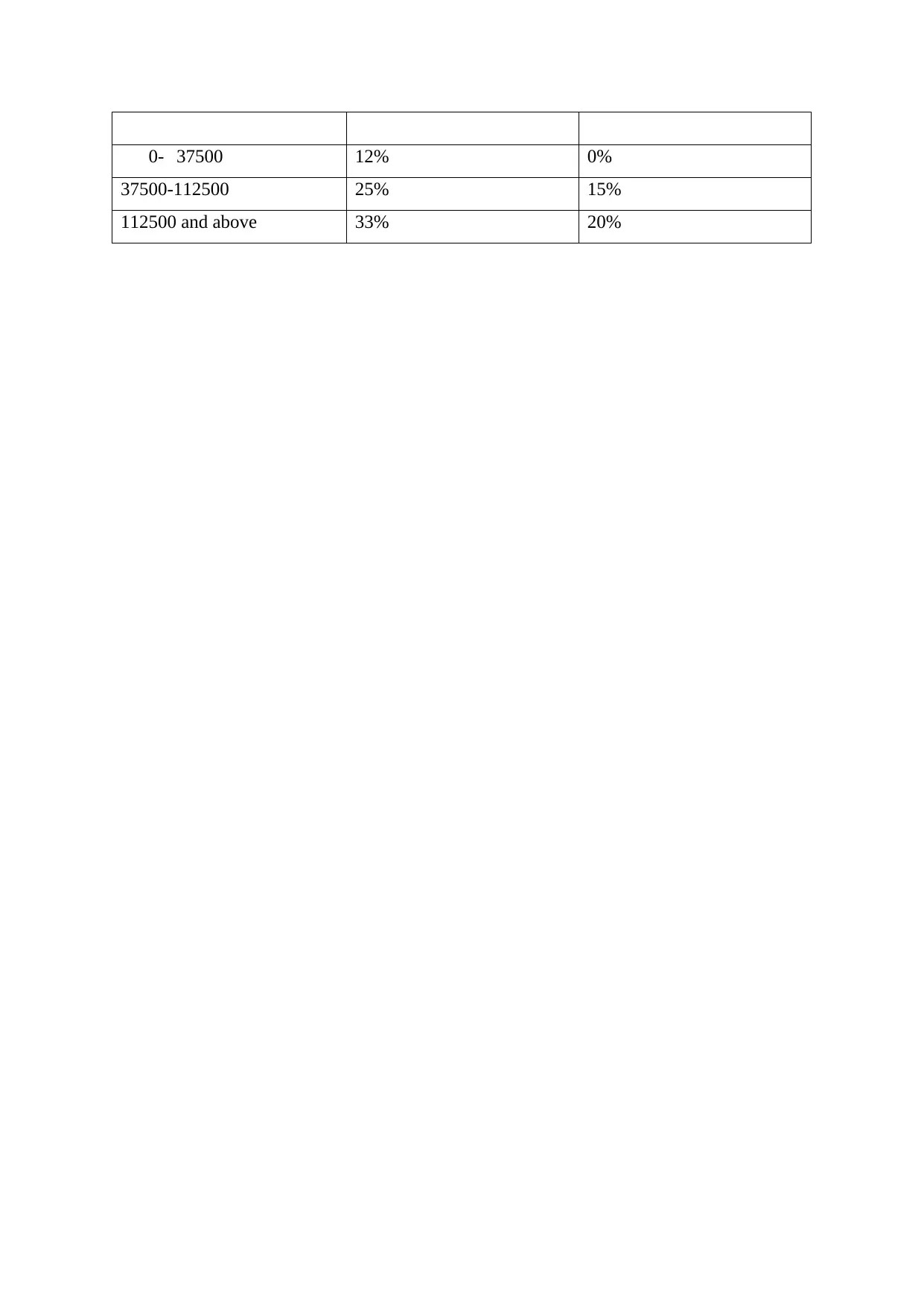
0- 37500 12% 0%
37500-112500 25% 15%
112500 and above 33% 20%
37500-112500 25% 15%
112500 and above 33% 20%
1 out of 8
Related Documents
Your All-in-One AI-Powered Toolkit for Academic Success.
+13062052269
info@desklib.com
Available 24*7 on WhatsApp / Email
![[object Object]](/_next/static/media/star-bottom.7253800d.svg)
Unlock your academic potential
Copyright © 2020–2025 A2Z Services. All Rights Reserved. Developed and managed by ZUCOL.





